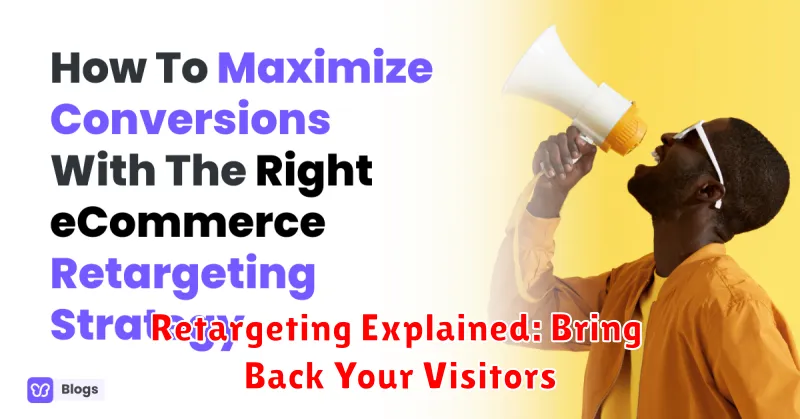Have you ever browsed a website, looked at a product, and then later seen ads for that same product following you around the internet? That’s retargeting, a powerful digital marketing strategy designed to recapture the attention of potential customers who have already interacted with your brand. Retargeting, sometimes called remarketing, leverages website visitor data to deliver highly relevant ads across various platforms, bringing them back to complete a purchase or further engage with your business. This powerful technique allows you to reconnect with your most valuable prospects – those who have already demonstrated interest – maximizing your return on ad spend and boosting your conversion rates.
This comprehensive guide delves into the world of retargeting, explaining how it works, why it’s crucial for your marketing strategy, and how to implement it effectively. We’ll explore different retargeting methods, discuss best practices for campaign optimization, and address common concerns surrounding user privacy. By understanding the power of retargeting, you can transform lost opportunities into conversions, strengthening your brand presence and driving significant business growth. Discover how to bring back your visitors and convert them into loyal customers with the power of retargeting.
What Is Retargeting?
Retargeting, also known as remarketing, is a powerful digital marketing strategy that allows you to reconnect with users who have previously interacted with your website or app. It works by tracking these visitors and displaying targeted ads to them as they browse other websites or use social media platforms.
Imagine a potential customer visits your online store, browses a few products, and then leaves without making a purchase. Retargeting enables you to “follow” this customer and remind them of the products they showed interest in. This gentle nudge can often be the difference between a lost opportunity and a conversion.
How does it work? A small piece of code, often called a pixel, is placed on your website. This pixel drops an anonymous cookie into the visitor’s browser. When this visitor then browses other websites within a participating ad network, the cookie allows the network to recognize them and display your ads.
Retargeting campaigns are highly effective because they focus on individuals who have already demonstrated some level of interest in your offerings. This targeted approach typically yields higher click-through rates and conversion rates compared to traditional display advertising.
Why Retargeting Works So Well
Retargeting, also known as remarketing, is a highly effective advertising strategy because it focuses on individuals who have already demonstrated an interest in your products or services. By targeting these “warm” leads, your ads become significantly more relevant and engaging.
Unlike traditional advertising that targets a broad audience, retargeting zeroes in on users who have visited your website, abandoned their shopping cart, or interacted with your brand in some way. This pre-existing familiarity significantly increases the likelihood of conversion. They’ve already shown interest; retargeting simply serves as a gentle reminder, nudging them towards a purchase.
Brand recall is another key factor in retargeting’s success. By repeatedly exposing your brand to these potential customers, you reinforce your presence and stay top-of-mind. This consistent visibility helps build trust and increases the chances of them choosing your brand when they’re ready to buy.
Furthermore, retargeting allows for precise targeting and personalization. You can tailor your ads based on specific user behaviors, such as the products they viewed or the pages they visited. This personalized approach resonates more effectively than generic advertising, leading to higher click-through rates and conversions.
Types of Retargeting Campaigns

Several types of retargeting campaigns cater to different marketing goals and user behavior. Pixel-based retargeting, the most common type, uses a tracking pixel to identify website visitors and serve them ads as they browse other sites. This allows you to re-engage users who have shown interest in your products or services.
List-based retargeting leverages customer data, such as email lists, to target ads on platforms like Facebook and Google. This method is highly effective for reaching out to known customers and tailoring ads to specific segments. For example, you can target a list of customers who abandoned their shopping carts with a reminder and a special offer.
Dynamic retargeting takes personalization a step further by displaying ads featuring the specific products or services a user viewed on your website. This highly targeted approach reminds users of their interest and encourages them to return and complete a purchase. Imagine a customer viewed a specific pair of shoes; dynamic retargeting would then show them ads featuring that exact pair.
Lastly, search retargeting focuses on users who have previously interacted with your website and are now searching for related keywords on search engines. This allows you to capture high-intent users actively looking for products or services similar to yours. This strategy effectively connects with users who are actively searching, indicating a stronger purchasing intent.
Pixel Placement Best Practices
Accurate retargeting relies heavily on correct pixel implementation. Misplaced pixels can lead to inefficient ad spend and inaccurate data collection. Therefore, understanding pixel placement best practices is crucial for successful retargeting campaigns.
Place your pixel across your entire website, not just specific pages. This ensures comprehensive tracking of user behavior and allows you to segment your audience effectively. While prioritizing key pages like product pages and checkout pages is important, website-wide placement captures valuable data from all visitors.
Ensure your pixel fires immediately when a user lands on your site. Delayed firing can result in missed opportunities to capture user data and personalize retargeting efforts. Prioritize a speedy website and a correctly implemented pixel to minimize delays.
Regularly test your pixel implementation to ensure it’s functioning correctly. Tools are available to verify pixel firing and data collection. Consistent testing helps identify and resolve any issues promptly, preventing data loss and maximizing the effectiveness of your retargeting campaigns.
Segmenting Retargeting Audiences
Segmenting your retargeting audiences is crucial for maximizing your campaign’s effectiveness. By dividing your audience into smaller, more specific groups, you can tailor your messaging and offers to resonate more deeply, resulting in higher conversion rates. This avoids showing generic ads to everyone who has visited your website, which can be ineffective and even annoying.
Common segmentation strategies include segmenting by:
- Website behavior: Target users who viewed specific product pages, added items to their cart, or initiated checkout but didn’t complete the purchase.
- Engagement level: Differentiate between new visitors, frequent visitors, and those who haven’t visited in a while.
- Demographics: Utilize demographic information, if available, to refine your targeting based on factors like age, gender, or location.
- Purchase history: Create segments based on past purchases to encourage repeat business or cross-sell related products.
By strategically segmenting your retargeting audiences, you can deliver the right message to the right person at the right time, leading to a more personalized and effective advertising experience and a stronger return on investment.
Dynamic Product Retargeting
Dynamic product retargeting takes retargeting a step further by showcasing specific products or services that a user previously viewed or interacted with on your website. This personalized approach delivers highly relevant ads, increasing the likelihood of conversion. Imagine a customer browsing running shoes on your site. With dynamic retargeting, they’ll later see ads featuring the exact shoes they looked at, along with similar items they might be interested in.
This strategy leverages a product feed, containing information like product images, prices, and descriptions. When a user interacts with your products, a tracking pixel captures their activity. This data is then used to generate customized ads displayed on other websites and platforms as they browse the internet.
Dynamic product retargeting offers significant advantages. It boosts brand recall by keeping your products top-of-mind, combats shopping cart abandonment by reminding users of items left behind, and improves ROI by showing ads to highly engaged potential customers.
Retargeting with Email
Email retargeting offers a personalized approach to reconnect with website visitors. It leverages email addresses collected through various means, such as newsletter sign-ups, abandoned carts, or account creations, to deliver targeted messages.
One common tactic is abandoned cart emails. These messages remind shoppers of items left in their online shopping carts, often offering incentives like free shipping or discounts to encourage purchase completion. Welcome emails are another example, nurturing new subscribers with valuable content and exclusive offers to foster engagement and brand loyalty.
Segmented email campaigns are crucial for effective email retargeting. By dividing your audience into specific groups based on browsing behavior, purchase history, or demographics, you can tailor messaging for maximum relevance. This personalized approach significantly increases the chances of converting website visitors into paying customers.
Avoiding Ad Fatigue
Ad fatigue is a significant hurdle in retargeting. It occurs when your target audience is repeatedly exposed to the same ads, leading to decreased engagement and even annoyance. This can negatively impact your campaign’s performance and brand perception.
Frequency capping is crucial. This limits the number of times a specific user sees your ad within a given timeframe. Experiment to find the optimal frequency for your audience. Start with a lower frequency and gradually increase it while monitoring performance.
Segment your audience to deliver more relevant ads. By dividing your audience into smaller groups based on their behavior or demographics, you can tailor ad creatives and messaging, keeping the content fresh and engaging.
Refresh your creatives regularly. Using the same images and copy can quickly lead to ad fatigue. A/B test different variations of your ads to identify high-performing creatives and maintain audience interest.
Burn codes can be implemented. A burn code, usually a pixel placed on a thank you page after a conversion, will prevent converted users from being re-targeted by your ad campaign.
Platforms That Support Retargeting
Several platforms offer robust retargeting capabilities, allowing businesses to re-engage their website visitors. Understanding the strengths of each platform can help you choose the best fit for your retargeting strategy.
Google Ads is a prominent platform for retargeting, offering a wide reach through the Google Display Network and Search Network. Its sophisticated targeting options allow for granular control over audience segmentation.
Facebook, renowned for its vast user base and detailed demographic information, provides powerful retargeting tools. It allows businesses to target users based on website activity, interactions with their Facebook page, and even offline conversions.
Other social media platforms like Instagram, Pinterest, and Twitter also offer retargeting features, each catering to their unique user demographics and behaviors. LinkedIn, a professional networking platform, enables businesses to retarget users based on their professional profile and activity.
Specialized retargeting platforms, such as Criteo and AdRoll, provide advanced features and cross-platform capabilities, often focusing on e-commerce and dynamic retargeting.
Tracking ROI Effectively
Tracking the return on investment (ROI) for your retargeting campaigns is crucial to understanding their effectiveness and optimizing for better results. Accurately measuring ROI involves monitoring key metrics and attributing conversions correctly.
Key Performance Indicators (KPIs) to monitor include website conversions (e.g., purchases, sign-ups), click-through rates (CTR), and cost per click (CPC). Analyzing these metrics in relation to your campaign spend provides insights into profitability. For example, calculate your ROI using this formula: (Revenue – Cost of Campaign) / Cost of Campaign * 100.
Use attribution models to accurately credit conversions to your retargeting efforts. Since retargeting often works in conjunction with other marketing channels, understanding its specific contribution is important. Explore different attribution models, like last-click or multi-touch attribution, to determine the most accurate reflection of your retargeting campaign’s impact.
Platform analytics dashboards and dedicated retargeting platforms provide tools to facilitate tracking and reporting. Leverage these resources to visualize data, create customized reports, and gain a comprehensive view of your campaign performance.

